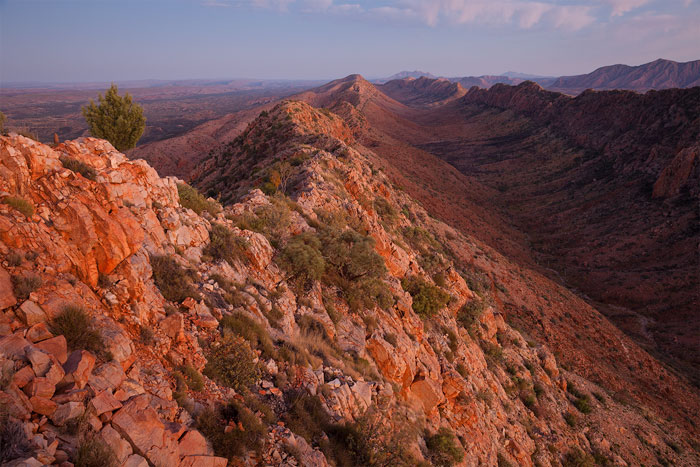
May 2012
West MacDonnell National Park, NT, Australia
Canon 5D MkII & EF 24-105mm f/4L IS USM, 2s f/8 ISO400 @32mm
The MacDonnell Ranges stretch out east-west for hundreds of miles across the desert in the center of Australia. Dry, rugged, and very sparsely populated, they are the ancestral home of the Arrernte people, one of the multiple aboriginal groups.
Aboriginal culture and spirituality are quite difficult to understand from outside. It derives from an interconnection of all elements of the Earth. The land is honoured as sacred and intimate connections between human beings and nature are celebrated. Aboriginal people are incredibly diverse, with over 230 languages and further dialects within each language. Each group has its own culture, spirituality and creation stories.
Although it is impossible to state a particular set of beliefs that apply to all aboriginal language groups, the following quote accurately summarizes some core beliefs: "We don't own the land, the land owns us. The land is my mother, my mother is the land. The land is the starting point from where it all began. It's like picking up a piece of dirt and saying this is where I started and this is where I'll go. The land is our food, our culture, our spirit and identity."
Central to aboriginal spirituality is the concept of dreaming or dreamtime. It refers to a "time outside of time" and spiritual plane from which ancestor beings rose and roamed the initially barren land, fought and loved, and created the land's features as seen today. Each aboriginal person identifies with specific dreamtime stories, in which contact is made with the ancestral spirits. Thus, the dreaming gives aboriginals an identity and dictates how they express their spirituality. Within these sacred stories are also embedded the laws governing the relationships between the land, people and spirits. Legends of the dreamtime are handed down by word of mouth and by totem from generation to generation. Songs, stories, rituals, places and symbols bring life to the power of dreaming.
All aboriginal groups have a slightly different version of the "Rainbow Serpent" story, which is perhaps the oldest continuing religious belief in the world, dating back several thousands of years. The rainbow serpent is always associated with watercourses, such as billabongs, rivers, creeks, and lagoons, and is the protector of the land, its people, and the source of all life, although it can also be a destructive force if not properly respected.
The most common version of the rainbow serpent story tells that in the dreaming, the world was flat, bare and cold. The rainbow serpent slept under the ground with all the animal in her belly waiting to be born. When it was time, she pushed up, calling to the animals to come from their sleep. She threw the land out, making mountains and hills, and spilled water over the land, making rivers and lakes. She made the sun, the fire and all the colours.
Another popular story in Central Australia is that of the Yeperenye or caterpillar, which explains how the MacDonnell Ranges were created by great mounds of carcasses of caterpillars when they lost a great battle with their enemies, the stink bugs. The caterpillars came from different places known today as Mount Stuart in the north, Finke in the south, Atula in the east and Mount Zeil in the west. Gaps in the range are said to have been formed when the heads of caterpillars were bitten off by the stink bugs.
One can certainly start to believe in these stories when camping in the above shown spot after days of walking through these mountains under the relentless sun. Views like these are what made everything worthwhile, but that is story already told here.